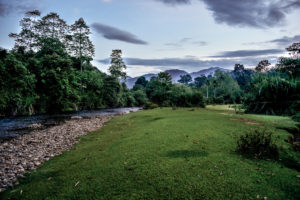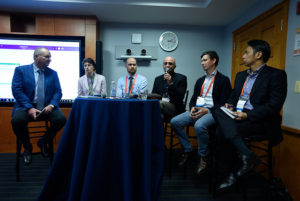
It is almost 10 years since the birth of REDD+, the UN-backed program to incentivize forest restoration and conservation in developing countries, as part of a worldwide effort to reduce emissions and increase carbon stocks.
The program, also tailored to contribute to national sustainable development, has been heralded as a powerful part of the solution to both poverty and climate change.
But at a session entitled “REDD+ money for Green Results: What REDD+ Needs to Succeed,” hosted by Center for International Forestry Research (CIFOR) and the CGIAR Research Program on Forests, Trees and Agroforestry (FTA) at the Global Landscapes Forum Investment Case Symposium in Washington, the debate ran fast and hot.
CGIAR Research Program on Forests, Trees and Agroforestry (FTA) research leader Christopher Martius, who is also CIFOR’s climate change team leader and panel moderator, set the stage for a discussion that would be both productive and critical as some delegates debated its efficacy and future potential.
Panelists acknowledged the extent of the challenges facing the voluntary climate change mitigation approach program, but also came forward with a range of useful propositions for helping achieve the emission reduction results so urgently needed.
Deforestation and forest degradation account for 11 percent of greenhouse gas (GHG) emissions, more than the entire global transportation sector and second only to the energy sector, according to data from the UN-REDD Programme, which works with developing countries in an advisory role to help implement REDD+ technical support services tailored to national circumstances and needs.
Watch: REDD+ money for green results? What REDD+ finance needs to succeed
REDD+: SMALL FISH IN A BIG POND?
Gabriel Labbate, regional coordinator of the Latin American and the Caribbean region for the Poverty-Environment Initiative (PEI) and the UN REDD program, estimated that around $400 million are dispersed for REDD+ per year, plus another $600 million in finance for other kinds of sustainable forest management.
“That looks like a decent number,” he said. “Until you take a look at what was on the other side of the fence”: the money that’s simultaneously going toward industries responsible for emitting carbon and causing deforestation. For example, in 2015 the oil industry alone was subsidized to the tune of about $5 trillion.
Asgeir Olafson, Global Topic Lead on Land Use and the Bioeconomy at Scandinavian consultancy firm COWI A/S, also picked up on the need to look at the bigger picture and all the actors involved in order to make a real difference: “REDD is only one stream of money, alongside a lot of other streams of money, going into deforestation areas,” he said.
Labbate argued further that carbon markets are not yet lucrative or established enough to incentivize changes in practice on a wider scale, and Kaspar Wansleben, managing director of the Forestry and Climate Change Fund (FCCF), agreed: “It’s not considered by investors to be serious, stable and predictable enough to give them the 15-year perspective that they need to make something like this work.”
Challenges aside, some impressive progress has already been made under REDD+, said Labbate. According to the Lima REDD+ Information Hub, a platform for countries to report avoided deforestation, about 6 gigatons of carbon emissions have already been avoided as a result of the program. “I think it is remarkable that in this environment we still get these types of results,” he concluded.
Read also: New study finds little private finance in REDD+ efforts, suggests blended finance as way forward

PUBLIC-PRIVATE PARTNERSHIPS
One keenly-debated issue was the role of the public sector in both developing and developed countries, in getting REDD+ to perform better. Olafson stated that we should “expect no solution from policymakers. They have too many other urgent things to do.”
“The scope, and the level of ambition, and the political capital to being involved with REDD+, I’m sorry to say, is simply not there.”
But Abbate urged caution about dismissing policymakers’ importance in REDD+ discussions: “Markets don’t work in a vacuum. They work better in London than in the DRC [Democratic Republic of Congo], because the institutions around them are different,” he argued. “And the strength of the institutions in a country is a political decision, made by policymakers.”
Olafson acknowledged that governments could, at least, play a useful role in helping unlocking private finance to fund REDD+ activities. “There is plenty of finance out there,” he said. “We need private finance to be involved, and governments to help with that.”
Ellysar Baroudy, Lead Carbon Finance Specialist at the World Bank (WB), described a large-scale project the Bank is involved with in Mozambique. The country received $3.6 million from the Forest Carbon Partnership Fund to establish an enabling environment for private finance, and the WB contributed $5 million to the cause.
Forest sector reform and technical assistance were key aspects of this process, as these aspects that are difficult for private investors to fund. “Countries need time to get sorted and put in place a foundation first,” said Baroudy, “and then they can start to attract funding from a whole mosaic of different sources.”
But Dharsono Hartono, president director of PT Rimba Makmur Utama, an Indonesian based company developing a 108,255 hectare peatland forest REDD+ project in Central Kalimantan, opined that in the Indonesian context, too much money has already been poured into creating enabling conditions, and too little into the task at hand. As a result, he said, “in the last 10 years, deforestation hasn’t decreased.”
In the Indonesian context, the government will start getting involved only once the private sector takes the lead and starts making sales, Hartono continued. “So this is a lesson for us going forward: it’s not just about the typical donor countries working together, we need full collaboration between the private sector, donors, civil society and communities.”
This includes making sure that incentives are truly worthwhile for communities on the frontiers of deforestation, urged Wansleben: “We need to provide systems and build models that allow local communities to generate incomes and livelihoods from the first resources that come through, which are able to at least compete with other, more damaging kinds of land use.”
Olafson shared Hartono’s sense of urgency about getting started, rather than waiting for perfect knowledge and conditions. “We should dare to test 70 percent solutions,” he said.
Baroudy added that the “high bar” for sustainability expected of the land-use sector has gotten in the way of being able to pay for results early in the piece. “Let’s not expect the land-use sector to have to be the gold, platinum and everything else in terms of what you can do, because the more we wait, the more deforestation is happening,” she said.
Read also: Blend, bond and blockchain: The financial landscape is changing to fit the planet’s needs
BEYOND CARBON
Several panelists pointed out the progress the program has enabled beyond the realms of carbon finance. In Indonesia, said Hartono, “REDD+ changed the way the private sector does business. We started seeing that communities should be part of the equation.” Wansleben added that REDD+ has pushed emphasis on to creating better monitoring systems, which can then also be used for other projects.
In the bigger picture, the program has helped precipitate a shift from the development paradigm of the 1990s, said Labbate. At that time, the prevailing view was that countries should pay for their own development. In his opinion, REDD+ has helped cement a new approach that takes into account globalization, international inequality and historical contributions to environmental degradation and climate change, and calls on wealthier countries and individuals to contribute to poorer areas’ development in more sustainable ways.
Hartono remained hopeful that the best for REDD+ is yet to come. “The tipping point is almost here,” he said. “People understand carbon much more now than ten years ago; we are in a very exciting time.”
Baroudy was similarly hopeful. “I don’t give up,” she said. “I am totally an optimist in this space. I think it behooves on us all to really push the barriers and keep going, and to me there’s just no other option than to make it happen.”
By Monica Evans, originally published at GLF’s Landscape News.











